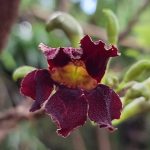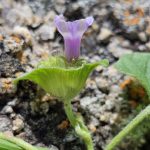TREE LIFE 523
MARCH 2024
FUTURE EVENTS
PLANNED EVENTS:- MARCH
Since inclement weather or other issues may vary our plans, please join our WhatsApp group (Tony Alegria on 0772 438 697) for last-minute updates.
Saturday 2nd March 2024:- visit to the National Botanical Gardens.
Meet at 8.30 in the main car park and join us for an interesting morning looking at trees that catch our interest.
Sunday 17th March 2024:- a visit to Christon Bank
This change is due to Easter occurring on the 4th weekend!
Directions: Take the Mazowe Road out of Harare past the toll gate, ($3) turning right to Christon Bank about 22.5 km from Harare. Follow the tarred road right down ignoring all the various turn-offs to right or left. Continue to the end of the tar (± 9 km) and park in the parking area on the right (labelled the Botanical Reserve).
We will be visiting a favourite spot at the Botanic Gardens Extension at Christon Bank. Christon Bank is situated about 30 km north of Harare. It is an area of rocky hillsides and Brachystegia boehmii dominated woodland near the Mazowe River. Several properties were donated to the National Botanical Gardens in the seventies and have been maintained and protected under the name Mazowe Botanic Reserve. At this time of year, there could be some interesting terrestrial orchids as well. It is a super place. Don’t forget the sunblock, and make the most of your entrance fee by bringing your chair, lunch, and cooler bag. Come for a restful and social lunch. You do not have to be a member to join us for the day. There is now a $2 entrance fee. We will meet at 10.00 a.m. in the car park. Note: I am not confident about the level of charge so be prepared!
REPORTS FROM PREVIOUS OUTINGS
NATIONAL BOTANICAL GARDEN OUTING SATURDAY 3RD FEBRUARY 2024
Text by Mark Hyde, photos all by Jim Dryburgh apart from the flowering Haplocoelum and the Terminalia fruit which are by Mark Hyde
Nine members of the Society assembled in the Botanic Garden carpark for the monthly Tree Society walk, led by Tony. Those present were Ann Sinclair, Anne Butler, Dido de Swardt, Jim Dryburgh, Frances and Peter Morris, Jan Van Bel, Mark Hyde and Tony Alegria.
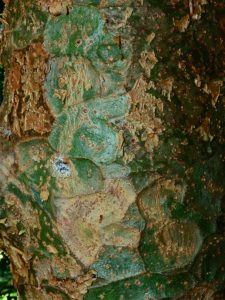
Commiphora ugogensis
Our first port of call was to the Commiphora ugogensis, River corkwood, not far from the carpark. This has classic Commiphora bark, green with a light peel and from the ground, we can see the leaves with their numerous leaflets far out of reach. In fact we have never actually been able to touch the leaves and the identification has been done from ground level with cameras and binos. This is a Zambezi Valley tree in Zimbabwe, but it has a wider range as far north as Tanzania; indeed the specific name refers to a place called Ugogo in central Tanzania where the type specimen was collected.
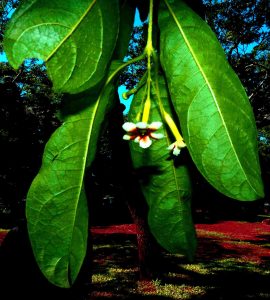
Schrebera trichoclada
Nearby we were surprised to come across a flowering specimen of Schrebera trichoclada, the Wooden pear or Sand jasmine. It is a feature of the Harare Botanic Garden, no matter how many times one visits, one comes across trees never noticed before.
This is the simple-leaved species of our two schreberas the other, S. alata has pinnate leaves. The flowers were white with patches of brown hairs near the throat of the corolla.
Near the thatched pump house is a tall shrubby, white-flowered species of Grewia. This has proved difficult to name in the past and despite my best efforts it remains so; I believe it to be G. pachycalyx but not all details seem right. Further work is needed!
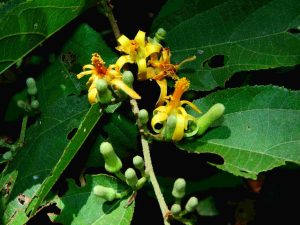
Grewia flavescens – (Donkey-berry)
We had a bit more luck with the next Grewia which was a yellow flowered one. This was Grewia flavescens (Donkey-berry) in full flower, nicely caught by Jim Dryburgh’s picture. Species of Grewia are not always easy to name and it is always vital to check in the field whether the stems are square or strongly angled, as this is impossible to detect from younger flowering parts. In this case, the stems were angled implying G. flavescens. There is a lot of this species in the Botanic Garden. Sometimes it is a large liane with the angled stems 10 cm in diameter.
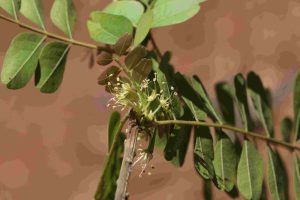
Haplocoelum foliolosum – flower
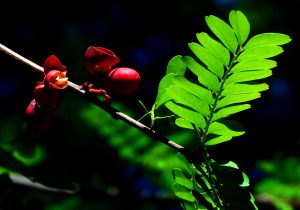
Haplocoelum foliolosum – fruit
Another useful feature of Botanic Gardens is that one can see rare trees in flower and fruit without the need to travel. There are two specimens of Haplocoelum foliolosum, (the Northern galla-plum), in dense shade which we have looked at many times searching for flowers or fruit. Recently we have been lucky; the trees flowered in October and on this visit, we came across the red fruit. The flowers are not very exciting as they lack petals and the sepals are green. The fruits however are more noticeable as they are bright red.
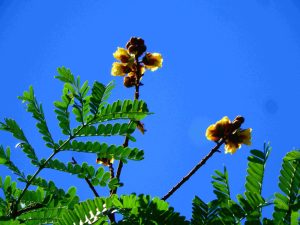
Possible Peltophorum
unknown species
By this time we had reached the open area towards the herbarium. This is an area of exotic species chosen for their spectacular flowers or architectural appearance. Tony, Jan and I in our tree labelling exercise in the Botanic Garden have struggled to name many of these. One tree we had provisionally named as an Albizia turned out to have yellow flowers borne on erect stalks above the leaves – clearly no albizia! In fact we now think this is a species of Peltophorum. There are three trees, the one nearest the entrance road is Peltophorum dubium, the other two remain unknown. Again, further work is necessary!
[Note added by Mark: both the unknown trees were later identified as Peltophorum pterocarpum, known as the Yellow flamboyant, native to Asia and Australia].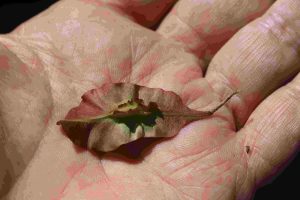
Terminalia mantaly
By the entrance road is Terminalia mantaly, a Madagascan endemic, named after Mantaly, a town in Madagascar. This tree with its distinctive whorled branches has exploded in popularity in recent years but despite looking out for them I have never seen it flowering or fruiting. This tree was in fruit and the fruits turned out to be typical 2-winged terminalia-like but with some longitudinal raised ridges over the central seed.
Once again, thanks to Tony for leading such an interesting walk; there’s always something new in the Botanic Garden.
Mark Hyde
A VISIT TO 12 A GILMORE DRIVE, HOGARTY HILL, SUNDAY 18TH FEBRUARY 2024:
(THANKS TO ANTHONY AND MIEKE MANNING)
Seven members of the Society turned up at the home of Anthony (“Ant”) and Mieke Manning at 12A Gilmour Drive in the Hogarty Hill area of Harare. They were Jan van Bel, Jim Dryburgh, Kevin Fallon, Lorraine Regadas, Mark Hyde, Vic Gifford and Zia Beaton. Together with our two hosts, we were a party of nine.
The area was originally a farm. It was subdivided into 4-acre plots and on one of these a magnificent, thatched property was built in 1998 by the late John Graham. The Mannings moved into it 12 years ago and immediately removed all the exotic species apart from a single large Jacaranda which produces such a spectacular annual show of flowers. Since then the Mannings have planted numerous indigenous trees as well as encouraging the naturally-occurring species. The house is positioned with splendid views over the surrounding countryside which is rapidly disappearing under new housing developments.
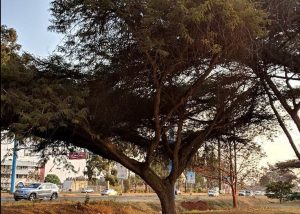
Vachellia (acacia) abyssinica
EDITOR’S NOTE: I was confused by the following but when checking with Mark it is another name change sent to try you. Vachellia abyssinica was Acacia abyssinica.
Near the carpark was a tall Vachellia abyssinica, the Nyanga flat-top, easily recognised by its long, narrow leaves and the twiggy nature of the upper parts.
Nearby was a smaller tree, which looked as if were on its last legs – but what was it? Vachellia sieberiana (the Paperbark acacia) or another Vachellia abyssinica? I think I managed to convince everyone it was sieberiana, on the grounds of the leaf shape and the thick pods typical of sieberiana, but its bark was not at all like a typical paperbark – there was no sign of anything flaking or peeling off. And nearby there was a typical sieberiana with a magnificent show of papery bark.
I think this illustrates a common problem with identifying trees in the wild. Species vary genetically and also through external influences such as fire, weather, age, insects, sickness and physical damage. This is particularly true of bark which may differ enormously. Plants are not like postage stamps and it can be quite difficult to name even common species.
Near the carpark we viewed a small cluster of planted indigenous trees, namely a flourishing baobab, two Schotia brachypetala (Weeping boer-bean), one oddly in brand new leaf, Bolusanthus speciosus, Tree wisteria and Stereospermum kunthianum, Pink jacaranda. These should produce a splendid show when they reach a size large enough to flower.
Also present were Syzygium guineense subsp. guineense, the Woodland waterberry and Kirkia acuminata, the White seringa. Both of these are indigenous species, although they were planted here, but close by was an Australian brush cherry, which is also a Syzygium. In most popular gardening books, this is called Syzygium paniculatum (sometimes also referred to as a Eugenia), and this is the name which many years ago, we gave it on our website. However, in April 2016, Dr Peter G. Wilson of the New South Wales Herbarium contacted me and informed me that our plants were S. australe and not the true S. paniculatum.
These Brush cherries, also known as lilly-pillies, are very common in Zimbabwean gardens and there is a degree of variation in what we see. Perhaps there is more than one species involved? Further work is needed to investigate further.
In the same area, there was a young, vigorous baobab. The smell of crushed baobab leaves is quite distinctive and slightly unpleasant. This particular tree had leaves with either 3 or 5 leaflets, but as is well-known, very young trees have only simple, unlobed leaves which can be very confusing. However, the young trees can still be recognised by their smell.
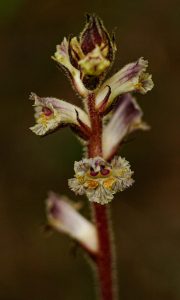
Orobanche minor
Someone pointed a small low-growing plant with purple flowers in woodland. This was a broomrape, Orobanche minor, a plant completely without chlorophyll which relies on its hosts for survival.
At the time, I believed the common name had something to do with rape, but in fact, the origin is a bit more innocent. According to reference [1] (see below), in this context, rape stems from the Latin word “rapum” which roughly translates to “tuber” or “turnip.” Broom is an English word that refers to Cytisus scoparius, a shrubby legume, which is often parasitized by broomrapes. So, the literal meaning of broomrape is something akin to “broom tuber.” In other words, they are plants growing on the roots of its hosts.
Towards the end of the walk, as we reached the main gate, Mieke pointed out an epiphytic orchid on a tree trunk. This is a common indigenous species of orchid, Tridactyle tridentata easily recognised by its rounded slightly fleshy stems.
Two species of Erythrina were seen, Erythrina abyssinica (Red-hot poker coral-tree) and E. lysistemon, the Sacred coral-tree. Both are good indigenous species and well worth growing for their attractive red flowers.
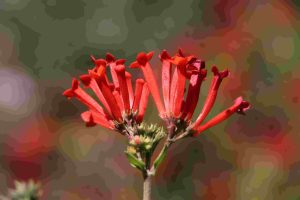
Bouvardia ternifolia – flower
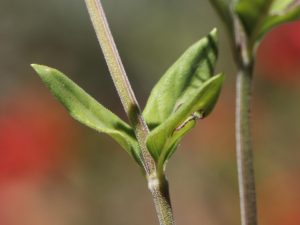
Bouvardia ternifolia – leaves in whorls
A final piece of botanical interest for me was a low garden shrub with brilliant red flowers which I had never seen before. This was not really a tree; it rarely exceeds 1 metre. It was Bouvardia ternifolia, a member of the coffee family with leaves in whorls of three. It is native to southern North America and Central America.
Finally, many thanks to Ant and Mieke for opening up their garden to us and for the hospitality at the end of the walk.
References: [1] https://www.indefenseofplants.com/blog/2017/5/3/broomrape-whats-in-a-name
Mark Hyde
OTHER ARTICLES OF INTEREST

With Beth Goodwin joining the society, I thought it would be of interest to find out more about My Trees Trust so here goes:
The My Trees goal is a reduction in the rate of natural woodland loss in Zimbabwe, in order to preserve biodiversity at scale within threatened landscapes. This involves:
- REPLANTING areas that have seen significant deforestation with suitable indigenous trees.
- PROTECTING large tracts of intact wilderness within Zimbabwe.
- PROVIDING ALTERNATIVE technologies and fuels to reduce pressure on local ecosystems.
To this end, they have managed to sponsor and create jobs in rural communities through the restoration work while establishing 30 nurseries with large seedling capacity while planting a large number of trees with an 86% average survival rate. On the conservation side, they have assisted with conservation management including the removal of snares, arrests for poaching and illegal activity, the patrolling of elephant-proof fencing and the rehabilitation of roads.
Most of the deforestation in Zimbabwe can be attributed to the tobacco industry. Firstly to clear the land to grow the tobacco, then to cure bricks to make tobacco barns, and finally to cure the tobacco leaves. For a normal small-scale barn 10-15kg of wood fuel generates heat to get 1kg cured tobacco so 15-22 tonnes of wood are needed per hectare of tobacco! In addition, wood-fuel is being cut for domestic use but a positive initiative has been the countrywide distribution of more efficient stoves with the knock-on effect that this leads to the reduction of CO2.
In their activities they work closely with rural district councils, traditional leadership, schools, and government entities such as the Environmental Management Agency, Forestry Commission, and Zimbabwe Parks and Wildlife Management Authority. So how can members of the Tree Society assist? Our skills lie mainly in identifying the trees as well as providing some historic background as to the makeup and extent of Zimbabwe’s forests. Recently there have also been discussions on the WhatsApp group surrounding the propagation of various indigenous plants. They also need assistance with site-species matching so that they plant the right species in the right areas. Donations are always greatly appreciated also.
I know this sounds trite but we should take any opportunity that presents to develop these skills and pass on the knowledge to all those we interact with. Remember every great tree starts as a seedling.
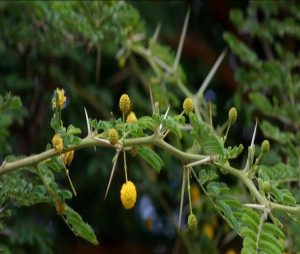
Acacia nilotica – photo by Bart Wursten from Zimbabwe Flora website
HOW AFRICA LOST ITS ACACIAS
By Andrea Bianchi, original author unknown
The genus Acacia is quite complicated with around 1,400 species, and there was a need to reorganize the genus. In 1986 the geneticist Leslie Pedley recommended that the genus Acacia should split up into three major groups plus other smaller groups.
The genus Acacia should only be used for the acacias with straight, paired thorns. He followed the taxonomy rule, “the earliest published name has precedence”! The first named acacia was Acacia nilotica (1753), which means sharp thorn from the Nile.
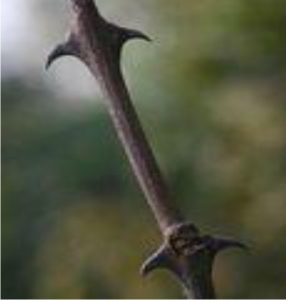
Acacia nigrescens changed to Senegalia nigrescens – photo by Petra Ballings from Zimbabwe Flora website.
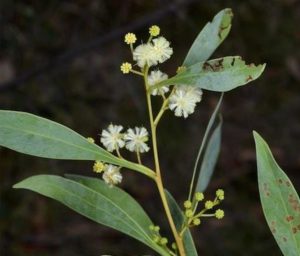
Australian Acacia penninervis (black wattle), photo Australian Plant Image Index (dig.30069).
The acacias with recurved, paired thorns should have the genus Senegalia and the Australian acacias (wattles) should have the genus Racosperma. It was a generally accepted attempt to reorganise the genus.
But the multi-billion dollar Australian agroforestry industry was against it. They wanted the acacia name for the Australian species. In 2005 two Australian botanists (Orchard & Maslin) suggested that the Australian Acacia penninervis (the black wattle) should be the norm for the genus acacia. The African acacias should have the genus names Vachellia and Senegalia.
The main argument was, there are 1000 acacia species in Australia and just 400 in Africa and South America and it is easier to change the genus name for 400 species rather than for 1000! The counterargument is that there are 25 million people in Australia and 2 billion people in Africa and South America so more people must learn the new names.
A further argument for keeping the acacia genus name to the African acacias is the name comes from “akis”, which is Greek and means “sharp point”. The Australian wattles have no thorns!
Orchard & Maslin’s suggestion went to the International Botanical Congress, in Vienna in 2005 and to the Spermatophyta Committee: (15 botanist = 10 Europeans and Americans and 1 African + 4 other). They ratified the Australian name change 9 – 6!
Plenty of protests came in and demanding at least 60% majority for a name change.
At the next International Botanical Congress held in 2011 in Melbourne the same issue was extensively discussed and explored. The ultimate decision was that to reject the new names – it needed 60% of the votes. It was a close-run thing with 67% of the delegates from America, Europe, Australia and New Zealand and only 4% from Africa. Unfortunately in this case the vote to keep the acacias in Africa lost so the new Australian name suggestion “won”.
I refuse to use the “new names”. As I understand, the International Botanical Congress can just recommend, not decide on the name changes and many botanic gardens are still using the “old” names!
Editor’s comment: To this day this issue remains emotional with nationalistic and even continental overtones leaving the call for arguments to remain factual.
EDITOR’S COMMENTS
With the additional articles this month, I cannot add anything more. If anyone has any short notes or longer articles, please let me have them. My contact details are below.
TREE SOCIETY COMMITTEE AND CONTACTS
Chairman Tony Alegria tonyalegria47@gmail.com 0772 438 697
Honorary Treasurer Bill Clarke wrc@mweb.co.zw 0772 252 720
Projects Jan van Bel jan_vanbel@yahoo.com 0772 440 287
Venue Organiser Ann Sinclair jimandannsincs@zol.co.zw 0772 433 125
Committee Member Ryan Truscott ryan.kerr.truscott@gmail.co 0772 354 144
Secretary Teig Howson teig.howson@gmail.com 0772 256 364
Tree Life Editor Linda Hyde Lmharwin@pentact.co.zw 0772 232 075
Tree Society Website https://treesociety.org.zw/
Tree Society Facebook https://www.facebook.com/groups/ztreesociety/
Flora of Zimbabwe: https://www.zimbabweflora.co.zw/
Flora of Tropical Africa: https://plants.jstor.org/collection/FLOTA


